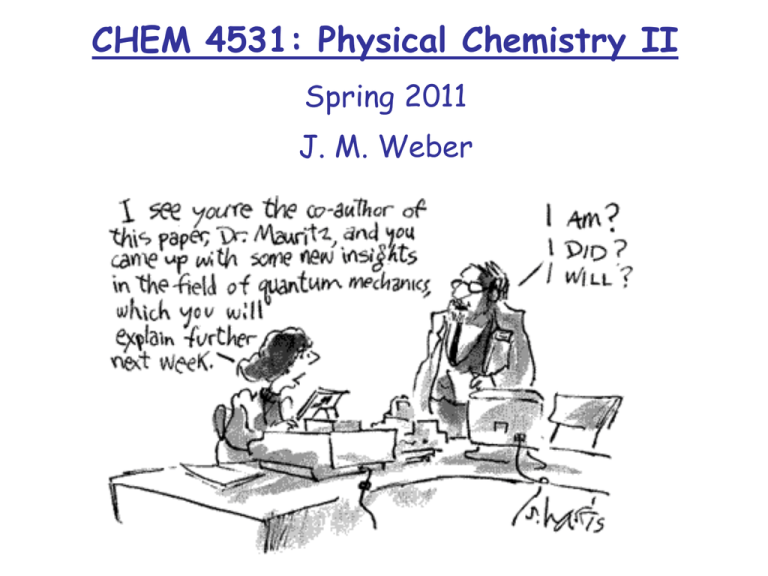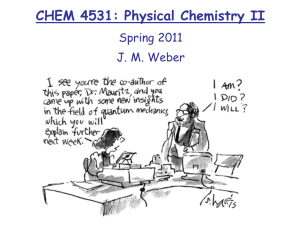CHEM 5581: Graduate Level Quantum Chemistry
advertisement

CHEM 4531: Physical Chemistry II Spring 2011 J. M. Weber Technicalities(1) • Requirements: – CHEM 4511 or 4411 – PHYS 1120 or 2020 – recommended: firm grasp of algebra, complex numbers, calculus, differential equations • Class hours: MWF 09:00 am to 09:50 am • Office Hours: M: 5 pm – 6 pm TF: 10:30 am – 11:30 am Technicalities(2) • Locations: – JILA tower A709 – phone 492-7841 – email weberjm@jila.colorado.edu – web site: http://jila.colorado.edu/weberlabs/course-CHEM4531.html • Exam schedule: – Two-hour exams: February 10, March 10, April 14 5-7 pm OR 6-8 pm, locations TBA – Final Exam: date, time, and location TBA Technicalities(3) • Problem sets (homework): – usually handed out (i.e. posted on course web site) on Wednesdays, to be returned the following Wednesdays before class – homework will be graded by graduate student TA (TBN) – credits accumulated over the semester determine your homework performance grade. Everyone may drop one homework assignment without penalty. • Travel: Due to conference travel, I will not give lectures on Feb. 2 and Feb 28. Another instructor may give the lectures in my stead. As the 2-hr exams are held outside of class hours, some class hours may be cancelled. At this time it is likely that there will be no lectures on Feb. 1, 28 Technicalities(4) • Additional lectures (voluntary): Cover some material in more depth, review some math and physics, do some computer experiments to enhance learning. Some Thursdays 6 pm – 7 pm, will be announced • Final grades: – homework performance: 40% – clicker questions (participation) 5% – average of the two-hour-exams: 30% – final exam: 25% Technicalities(5) • Textbooks: Required: Donald A. McQuarrie “ Physical Chemistry” Please note that reading material will be part of homework and relevant for exams. Optional: James R. Barrante “Applied Mathematics for Physical Chemistry” • Science Education Research How do people learn quantum mechanics? Program funded by the National Science Foundation Graduate student researcher in charge: Marta Maron Your cooperation will help future generation of students I will not see individual results from your input, only class average Clicker Questions and PowerPoint Slides will be shown on the course web site! Homework Assignments This Week • Read McQuarrie & Simon, Chapters 1, A, 2, B before Wednesday, January 19 • Problem Set 1: Mathematics due before class on Friday, January 14 • Problem Set 2 will be posted on Wednesday, January 12 due before class on Wednesday, January 19 Additional Lecture This Week: A Refresher on Complex Numbers Survey MASTERY OF THE KNOWN UNIVERSE (Graduate Course) From QM to Thermodynamics on a Molecular Level: Statistical Mechanics Spectroscopy Molecular Bonding Multielectron Atoms The QM Description of the H-Atom Vibrating Molecules: The QM Harmonic Oscillator Rotating Molecules: The QM Rigid Rotator Developing the Vocabulary of Quantum Mechanics: The Particle in a Box Where Classical Physics Fails … H l H Electromagnetic Spectrum Remote controls l = 980 nm MW ovens (2.45 GHz): l = 12.2 cm KBCO (97.3 MHz): l= 3.08 m KVOD (88.1 MHz): l = 3.33 m Solar Spectrum wavelength in Å Joseph von Fraunhofer, 1814 Radiation from hot objects Emission Spectra Emission spectrum of Hydrogen Emission Spectra Emission spectrum of Hydrogen Emission spectrum of Iron Kirchhoff’s Three Laws of Spectroscopy: • Light from a hot solid object has a continuous spectrum with no dark lines UV IR • The same light, passed through a cool gas has the same spectrum, but with certain wavelengths missing dark lines (absorption spectrum) • Light emitted by a hot gas bright lines superimposed on an otherwise black background emission spectrum Blackbody Radiation Thompson’s Plum Pudding Model raisins pudding electrons are discrete particles embedded in a smeared out positive background charge Rutherford’s Experiment detection of scattered 2+ He q 2+ He (a particles) 4 Au foil (ca. 10 atoms thick) Rutherford’s Experiment detection of scattered 2+ He q 2+ He (a particles) 4 Au foil (ca. 10 atoms thick) Rutherford’s Experiment Scattering Intensity (arb. units) Thompson model [°] Rutherford’s data Rutherford’s Experiment detection of scattered 2+ He q 2+ He (a particles) 4 Au foil (ca. 10 atoms thick) Atomic Spectra Matter Waves Louis Victor Pierre Raymond, 7e Duke of Broglie (1892 - 1987) Nobel Prize for Physics, 1922 < picture from www.wikipedia.org > Electron Microscopy Carbon Nanotubes Ebola Reston (Virginia) CdSe Nanoparticles








